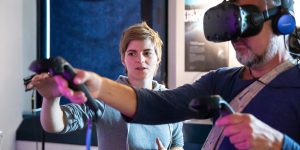haptic

Tangible Universe
Annika Kreikenbohm (DE)
In the study of the universe, light is the one of the main sources of information accessible to us. Using satellites and telescopes, we collect the light of astronomical objects. First, each object appears as a single cloud of light. In the closer analysis of light, we recognize its nature and can distinguish stars from galaxies. In the virtual environment, numerical satellite data is translated into light sculptures and light is made tangible by haptic stimuli.

Alternative sports viewing: Cross-modal appreciation of sports events
Junji Watanabe, NTT Communication Science Laboratories (JP)
Haptic communication technology and human information science can update inclusive sports viewing. By adding a haptic sensation to the viewing experience or converting a sports video into a haptic sensation, we present a novel form of sports viewing in which the spectators whether disabled or not, can enjoy a sports event with the vicarious excitement. Junji Watanabe attempts to re-create a sports viewing experience, which does not depend on visual or auditory stimuli, as conventional sports viewing does, and in which spectators can generate alternative reality of the event. Projects of “alternative sports viewing” are presented, achieved by adding or subtracting various sensations.


